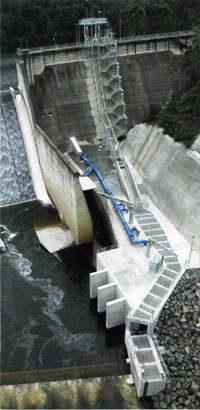Vivianne Richter, Cosmos Magazine (7 September 2015)
Scientists are going to great lengths to improve fish diversity in the Shoalhaven River.
Next time you run a tap, spare a thought for the thousands of migratory fish held up in the reservoir dams that provide us with drinking water.
Tallowa Dam stands 43 metres tall in the Shoalhaven River, New South Wales. The dam has supplied up to 30% of Greater Sydney's water during droughts. But "dams present a detrimental effect on fish migration," says Debashish Mazumder, environmental ecologist at ANSTO.
Dams keep water in, but keep fish out - unbalancing the local ecosystem. Some 96% of the fish in the Shoalhaven catchment are migratory. Plunging down a dam is easy for a fish. But unless you're a climber like the eel or can fling yourself over rocks like salmon, heaving yourself back upstream is impossible. Just 23 years after Tallowa Dam's construction, 10 of the Shoalhaven River fish species that must travel upstream to breed had completely disappeared from the river.
One of these fish, the Australian bass — a favourite among anglers — was hatchery-bred and released into the upper dam to top up the population. But other species — including some of the bass's favourite prey fish - were not being replenished.
So in 2009 the Sydney Catchment Authority built a "fish lift" — a 2,500-litre shuttling device, a bit like an apartment block elevator. It's not yet working at full capacity, but is expected to scoop and cart fish up and over the dam around 20 times a day.
 |
| The Tallowa Dam fish lift provides a mechanical shuttle to carry fish over the dam wall. Credit: Chris Walsh |
To find out if the fish lift has rebalanced the food web, NSW Fisheries scientists collaborated with Mazumder to analyse invisible trackers in the fish by examining what the fish ate.
— producing carbon-12, carbon-13 or carbon-14 isotopes. Similarly, nitrogen, which normally has seven protons and neutrons, can also have eight neutrons.
Your personal ratio of these naturally occurring stable isotopes, known as carbon-13 or the nitrogen-15 varieties, will be similar to your favourite foods. If you only eat one species of fish, those ratios in your muscle will be close to of that species. Mazumder describes isotopes as a "natural tracer".
So Mazumder's team analysed muscle samples of five species — the Australian bass, three species of its favourite prey and the introduced carp - collected above and below the Tallowa Dam before the fish lift fully kicked into gear. Each sample was dried, ground to a fine powder and packed into tin capsules.
The powder was incinerated in the capsules at 1,800 °C to form a gas. This gas was bombarded with electrons in an isotope ratio mass spectrometer, creating ions of different masses which were counted on a detector. The instrument was then able to calculate the ratios of different isotopes of
particular elements.
Fish with greater variation in their carbon-13 or nitrogen-15 ratios cast a wider food web. Mazumder's study showed that while the fish downstream grazed widely, those above were stuck with a short set menu.
The results confirmed ANSTO's isotopic technology as a means to check up on the Tallowa Dam ecosystems, especially once the lift is in full operation. Mazumder anticipates the fish above the dam will soon be able to have a more balanced diet. © Cosmos
Published: 02/09/2015


